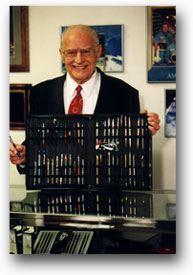|
Fisher Space Pen Co. That won't happen with Fisher Space Pens. These pens are really scientific wonders - something
out of this world - literally. That's because NASA officials
make sure each astronaut carries a Fisher pen tucked in
his or her spacesuit. Even the Russian cosmonauts use
them. Paul Fisher of Boulder City, NV., invented the pens in
the early 1960s. He founded the company in 1948 to make
ballpoint pens. Fisher had previously worked for Milton
Reynolds, the man who introduced ballpoint pens to Americans
in 1945. Fisher came up with the idea of sealing a ballpoint pen
cartridge and pressurizing it, so ink wouldn't be exposed
to the elements of extreme heat and cold in Outer Space.
He also developed a patented ink formula of synthetic
resins that was thick in texture, but would flow freely
when stirred by the movement of the ballpoint pen's rolling
ball. "In 1965, when man had started to fly into Outer
Space, I thought, `They will need a pen with a sealed,
pressurized ink cartridge, so that it can be used in the
boiling heat and vacuum of Outer Space..." Fisher's invention revolutionized the ballpoint pen industry.
The ink cartridge's ability to withstand boiling heat
of 250 degrees Fahrenheit and extreme cold of minus 30
degrees Fahrenheit was astonishing. Today, at 86 years of age, Fisher remains active in the
everyday activities of the Fisher Space Pen Co., located
on top of a hill at 711 Yucca St. in Boulder City, NV.
He keeps an apartment above his factory and frequently
comes down to experiment with new inks, or to make adjustments
on the 25- and 40-year-old machines that spit out some
30,000 ballpoint refills a day. "I still try to work 60 hours a week,'' Fisher says
while giving a visitor a tour of the machine shop and
ink department. "I may be prejudice, but I think we make
the best pen. And I'm not the only one.'' In fact, a well-known German company that manufactures
refills for the Mont Blanc pen company came to his factory
and offered to buy his ink, but he wouldn't sell. They
were impressed with its ability to not smear or ooze out
the tip of the ballpoint. "Our inks will actually withstand 400 degrees Fahrenheit,''
Fisher says with a smile. "The only problem is that
the blue turns to green at that temperature, but the blacks
have no problem." Besides the pressurized cartridge and special inks, Fisher
says what makes his pens so unique are the tungsten carbide
ball and socket. Peering through a high-powered microscope,
Fisher points out that the edge of the socket holding
the ballpoint is beveled. This allows the ball to always
touch the paper's surface, even when held at an angle,
so the ink continuously flows. These innovative designs enable the space pens to write
longer, upside down and more evenly, Fisher says. And
two new designs, the Millennium and Mars Pens, never need
a refill. The Millennium model is guaranteed to write
for more than 30 miles, or the equivalent of 80 years. The Mars pens are guaranteed to write satisfactorily
until mankind sets foot on the planet Mars, Fisher Space
Pen Co. advertisements proclaim. "We are the official pen of the U.S. Ski Team,"
says Morgan Fisher, vice president and Paul's son. "We
give 10 percent of the proceeds from each pen to the ski
team. We are the official pen of the Thunderbirds (Air
Force aerobatic team), and also the official Star Trek
pen." Morgan Fisher says the company did approximately $10
million in gross sales worldwide in 1999. The company
produces a line of 30 pens and is constantly adding new
models. The latest, called the World Peace Pen, sports
a globe-like fixture on top that when turned exposes the
ballpoint. The pen will be given to anyone who promotes world peace
and harmony, Paul Fisher says. Currently, the Fisher Space
Pen Co. employs 80 people at its facility located 25 miles
southeast of Las Vegas. "I work as a team,'' Paul Fisher says. "No
individual is smart enough to run a pen company by himself.
I come up with 90 percent of the ink here, but I never
make ink without consulting two or three assistants. First
you need an open mind, and then you need all the experience
around that you can get." As an interesting footnote, the Fisher Space Pen not
only has the distinction of being the first pen carried
to the moon, but also the first and only pen used to rescued
a NASA spacecraft. When Apollo 11 astronauts Neil Armstrong and Buzz Aldrin
were preparing to leave the moon's surface in July 1969,
one of them accidentally bumped and broke the arming switch
to the rocket engines. It looked like they would not be
able to start the engines because they had thrown out
all their tools and excess gear in order to lessen the
load at liftoff. Mission Control in Houston suggested that the Fisher
Space Pen they were carrying be used to activate the switch.
Aldrin was able to successfully reach the inner workings
of the switch with his pen, and the astronauts were able
to blast off and join astronaut Michael Collins for their
long journey home. In the annals of space-travel history, that little feat
was definitely something to write home about. For more information, contact the Fisher Space Pen Co.,
711 Yucca St., Boulder City, NV. 89005-1905. Phone: (702)
293-3011. Fax: (702) 293-6616. Web Site: www.spacepen.com
|
|||||
